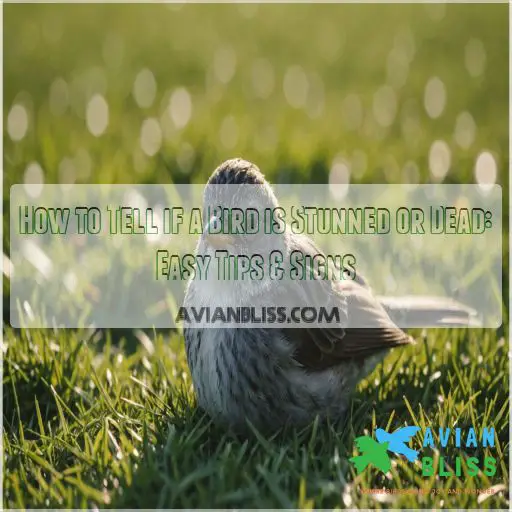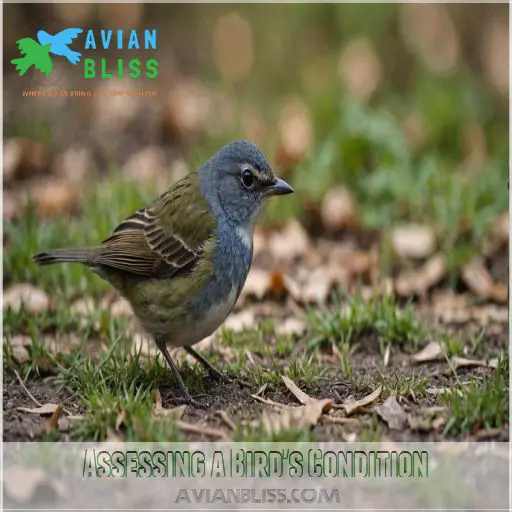This site is supported by our readers. We may earn a commission, at no cost to you, if you purchase through links.
 Wondering how to tell if a bird is stunned or dead? It’s a bit like playing detective but with feathers involved. First, check for any slight chest movement or blinking eyes—these are clues that the bird might be taking a timeout after a rough day.
Wondering how to tell if a bird is stunned or dead? It’s a bit like playing detective but with feathers involved. First, check for any slight chest movement or blinking eyes—these are clues that the bird might be taking a timeout after a rough day.
If the legs are stiff as a board, it’s sadly game over. A stunned bird might look dazed, practice yoga-like poses, or give off the vibe of a tiny, feathered mime artist. Gently assess the situation and remember, like any good mystery, the truth often lies in the details.
Want to uncover more bird-saving tips? Keep reading!
Table Of Contents
- Key Takeaways
- Assessing a Bird’s Condition
- Identifying Stunned Birds
- Signs of a Stunned Bird
- What to Do With a Stunned Bird
- Determining if a Bird is Injured
- Reporting Dead or Sick Birds
- Frequently Asked Questions (FAQs)
- How long do birds stay stunned?
- What does a bird in shock look like?
- Can a bird die from being stunned?
- What are the symptoms of a stunned bird?
- How can I prevent birds from hitting windows?
- What should I do if I find a sick bird?
- What signs indicate a birds poor health?
- How do I safely transport injured birds?
- When is expert intervention necessary for a bird?
- Conclusion
Key Takeaways
- Observe from a distance first like a curious detective—look for slight chest movements or blinking eyes. These hints might show the bird is taking a little time out, rather than reaching the end of its flight path.
- Get up close to check for signs of breathing and a heartbeat. Gently place your fingers on its chest to feel for a heartbeat. If you feel movement, this bird is just on pause, not a permanent one.
- Check the bird’s eyes: blinking or lively eyes mean there’s still life in the little guy. It’s like when you’re sleepy but still manage to watch your favorite show—life is happening, just in slow motion.
- If you find a stunned bird, become its temporary nurse. Create a safe, quiet spot for recovery, like offering a feathered friend a 5-star spa retreat away from curious cats and noisy neighbors.
Assessing a Bird’s Condition
Spotting a bird that might be injured or worse can be nerve-wracking, but don’t worry—you can figure it out with some easy observations.
By watching from a safe distance and checking for things like breathing, eye movement, and overall stiffness, you can tell if the little feathered friend needs help or not.
Observing From a Distance
Standing like a curious detective, observe the bird’s behavior from afar.
Notice its stance and movement.
Is it maintaining its usual vibrant color, blending naturally into its environment, or acting like a mime frozen in space?
A bird that appears static might just need bird care or rescue.
Engaging your inner Sherlock, analyze without startling it.
Checking for Signs of Breathing and Heartbeat
Next, you’ll want to get a closer look at the bird’s breathing and heartbeat.
Gently pick up the bird and place your fingers lightly on its chest.
Look for the rise and fall of its chest, which indicates breathing.
You can also feel for a palpable heartbeat.
These signs of life are important in determining if the bird is merely stunned or tragically deceased.
Examining the Bird’s Eyes for Signs of Life
After checking for a heartbeat or breathing, shift your focus to the bird’s eyes for signs of life.
Healthy eyes will be open or blinking, and pupillary reflexes should be present.
If the eyes are closed or appear dull, the bird may not have much life left.
Avoidable misunderstandings include assuming a sick bird is merely stunned.
Keep examining those eye reflexes!
Conducting a Physical Examination for Injuries
If the bird’s eyes seem lively, it’s time for a gentle physical exam to rule out injuries. Think of it like examining delicate china—handle with care!
Physical Exam
- Feel its wings and legs for fractures.
- Check the beak and feathers for abnormalities.
- Inspect the chest and abdomen for wounds.
- When in doubt, consult wildlife rescue professionals.
Identifying Stunned Birds
Ever watched a bird hit a window and wondered if it’s just stunned or actually gone?
This section will help you spot the difference, so you can play bird detective with ease.
Common Causes of Stunned Birds
Birds can become stunned from a variety of causes, like colliding with windows, getting attacked by cats, or falling from nests.
If you spot a bird that seems dazed or unresponsive, it may be stunned and in need of help.
Contact your local wildlife rescue or animal hospital for guidance on how to safely assist the bird.
Recognizing Symptoms of Stunned Birds
Stunned birds often look like they’re just taking a break from their sky-high antics. Recognize these symptoms to lend a hand:
- Disoriented Behavior: The bird wobbles or sits dazed, like it’s had one too many cups of birdseed brew.
- Wing Position: Wings may be hanging awkwardly.
- Eye Signs: Eyes open but unfocused, signaling a need for a short rest.
Distinguishing Stunned Birds From Dead Birds
Spotting a stunned bird can feel like finding a needle in a haystack, especially if it appears lifeless.
The key lies in observing subtle signs.
A stunned bird might blink or have a slight chest movement.
In contrast, a dead bird is usually cold, stiff, and unresponsive.
So, patience and a keen eye help the bird’s safe recovery.
Signs of a Stunned Bird
When you stumble across a motionless bird, it can be hard to tell if it’s just having a time-out or if it’s really in trouble.
Don’t panic—there are telltale signs to help you figure it out, like some detective work minus the magnifying glass!
Physical Characteristics of Stunned Birds
A stunned bird may appear stiff and unresponsive, with ruffled feathers and labored breathing. Their eyes may be open but glazed over, lacking the usual alertness. You might notice the bird struggling to maintain balance or making jerky, uncoordinated movements.
These physical signs suggest the bird is stunned and in need of immediate assistance.
Behavioral Signs of Stunned Birds
Imagine you’re Sherlock Holmes, observing a stunned bird for clues.
Look for wing drooping or a slight head tilt, like a confused tourist.
Blinking eyes indicate it’s dazed, not dead, while beak clicking mimics a slightly annoyed chatter.
Don’t be fooled by fluffed feathers—it’s the bird’s cozy blanket, not always a sign of distress.
Difference Between Stunned and Dead Birds
Spotting the difference between a stunned and dead bird might seem like trying to solve a mystery.
A stunned bird shows bird eye signs like blinking or slight movement.
Meanwhile, a dead bird lacks any bird breathing or movement.
Bird stiffness and a limp posture can also clue you in.
It’s like your natural detective instincts kick in!
What to Do With a Stunned Bird
If you find a stunned bird, your mission is to give it a safe, quiet place to recover, away from predators and noisy neighbors.
Picture yourself as a bird nurse, with a cozy box ready to be the bird’s temporary hospital room.
Providing a Safe Environment
Providing a safe environment is key when dealing with a stunned bird.
Create a bird-friendly space free from predators, noise, and commotion.
Offer food, water, and nesting materials to help the bird recover.
Resist the urge to touch or move the bird – let it rest in a quiet, secure spot until it regains its strength.
How to Contain and Secure an Injured Bird
When handling an injured bird, channel your inner Florence Nightingale. Gently scoop it up, ensuring its wings stay close to its body. Use a small box lined with a towel for safe transport, offering a cozy, temporary shelter. Remember, you’re providing humane care and first aid—perhaps ask the bird not to tell its friends about the cozy human hospitality.
- Line box with a soft towel: Add comfort and security.
- Keep bird’s wings folded: Prevent further injury.
- Place in quiet area: Minimize stress and disturbances.
Where to Bring an Injured Bird for Help
Finding help for an injured bird? Like finding a needle in a haystack, it can seem tough! But you’ve got options: Wildlife rehab centers and bird rescue groups are your best bet.
Local vets and animal shelters can lend a hand, too.
Bird sanctuaries also welcome winged visitors. Just call ahead and make sure they’re ready for your feathered friend!
Determining if a Bird is Injured
Identifying whether a bird is injured can feel like solving a mystery, but don’t worry, you’ve got this!
With a quick check for visible injuries and a gentle touch to assess for any hidden ones, you’ll be ready to help your feathered friend.
Looking for Visible Injuries
When checking a bird’s condition, carefully examine its body for any visible injuries. Look for feather damage, wing fractures, beak deformities, eye injuries, or leg issues. Gently feel the bird’s limbs and inspect its feathers for signs of trauma. These external clues can provide valuable insight into the bird’s overall health and guide your next steps in providing care.
- Feather damage
- Wing fractures
- Beak deformities
- Eye injuries
- Leg injuries
Checking for Internal Injuries
You’ve checked for visible injuries, now let’s see if there are hidden ones. Gently feel for internal injuries like unusual lumps or swelling, which might mean a wing fracture or leg injury. Birds won’t tell you they’ve got broken bones, but careful observation is key.
| Sign | What to Look For | Emotional Impact |
|---|---|---|
| Wing Fractures | Unnatural wing position | Heart-wrenching |
| Leg Injuries | Limping or immobility | Concern and empathy |
| Internal Bleeding | Darkened skin under feathers | Worry and urgency |
How to Handle an Injured Bird
Taking care of an injured bird’s a bit like being their superhero. Keep calm and make sure the bird is safe:
- Gently wrap the bird in a soft cloth for support.
- Avoid handling it too much; stress is a real villain.
- Place it in a quiet, warm spot.
- Contact a wildlife rehab center for expert bird first aid and rescue.
Reporting Dead or Sick Birds
When you come across a dead or sick bird, it’s important to act to help monitor and protect local wildlife.
Don’t just wing it; report it to the right authorities because your action could make a big difference!
Importance of Reporting Dead or Sick Birds
Reporting sick or dead birds is really important for monitoring disease spread and protecting avian populations.
Your observations can aid conservation efforts and help experts track wildlife health.
Consider it a small but meaningful way to make a difference.
Take a look at this handy table to learn where and how to report your findings.
| Organization | What to Report | Contact Info |
|---|---|---|
| Garden Wildlife Health | Sick birds, beak deformities | www.gardenwildlifehealth.org |
| British Trust for Ornithology | Beak deformities | www.bto.org |
| Defra | Dead waterfowl, other birds | www.gov.uk/defra |
How to Report Dead or Sick Birds
So, you’ve spotted a bird that seems unwell or worse. Don’t just wing it—instead, report it! For avian flu concerns or bird rescue situations, contact Garden Wildlife Health using online reporting methods.
Identifying birds correctly helps monitor wildlife health. Think of it as contributing to a community watch, ensuring our feathered friends stay safe and sound.
Frequently Asked Questions (FAQs)
How long do birds stay stunned?
If a bird’s stunned, it’ll likely recover within 2 hours.
Just keep it in a ventilated box and monitor it.
But if it hasn’t perked up by then, it’s time to call in the experts.
What does a bird in shock look like?
A bird in shock might sit quietly, appear ruffled or dizzy, and have rapid, shallow breathing.
It looks like it just survived a rollercoaster ride.
Gently approach, and let it rest somewhere safe and quiet.
Can a bird die from being stunned?
Birds can die from being stunned, often due to injuries sustained during impact, like flying into a window.
Monitor breathing and movement to assess recovery, and minimize stress by providing a quiet, dark environment for rest (Source).
What are the symptoms of a stunned bird?
You know a bird’s just stunned when it’s doing a little chest dance with shallow breaths, maybe blinking confusedly like it had a rough night out.
Keep an eye on those open eyes—they’re usually a good sign.
How can I prevent birds from hitting windows?
Tired of those pesky feathered friends crashing into your windows?
Slap on some bird-friendly decals, and you’ll be the talk of the neighborhood – no more winged wrecking balls on your watch!
Easy-peasy, bird-friendly breezy.
What should I do if I find a sick bird?
Stumble upon a sick bird?
First, let it be and check bird flu guidelines.
If it’s not flying the coop, report it to Garden Wildlife Health and keep pets at bay.
Experts will handle the rest!
What signs indicate a birds poor health?
Did you know 15% of birds appear fluffed up when sick?
It’s like a bird’s SOS – subtle, yet important to catch!
Spot poor health by noticing raggedy feathers, labored breathing, or unusual head tilting.
How do I safely transport injured birds?
To safely transport injured birds, scoop them gently into a ventilated box lined with a soft cloth.
Avoid using too much force – birds are like delicate china!
Secure the box and contact a wildlife expert pronto.
When is expert intervention necessary for a bird?
Expert help is really important if a bird shows signs of severe injury, such as bleeding, broken limbs, or inability to move.
Don’t hesitate – contact a wildlife rehabilitator right away to make sure the bird receives proper medical care. (Source)
Conclusion
Picture yourself as a bird detective, gathering clues to determine how to tell if a bird is stunned or dead. Remember, it’s all in the details—observe closely for breathing, stiff legs, or sleepy yoga poses.
Providing care, securing the bird, and knowing when to seek help can make all the difference.
Being informed equips you to act compassionately and effectively, ready to save the day and maybe even earn your feathered friend’s gratitude.









